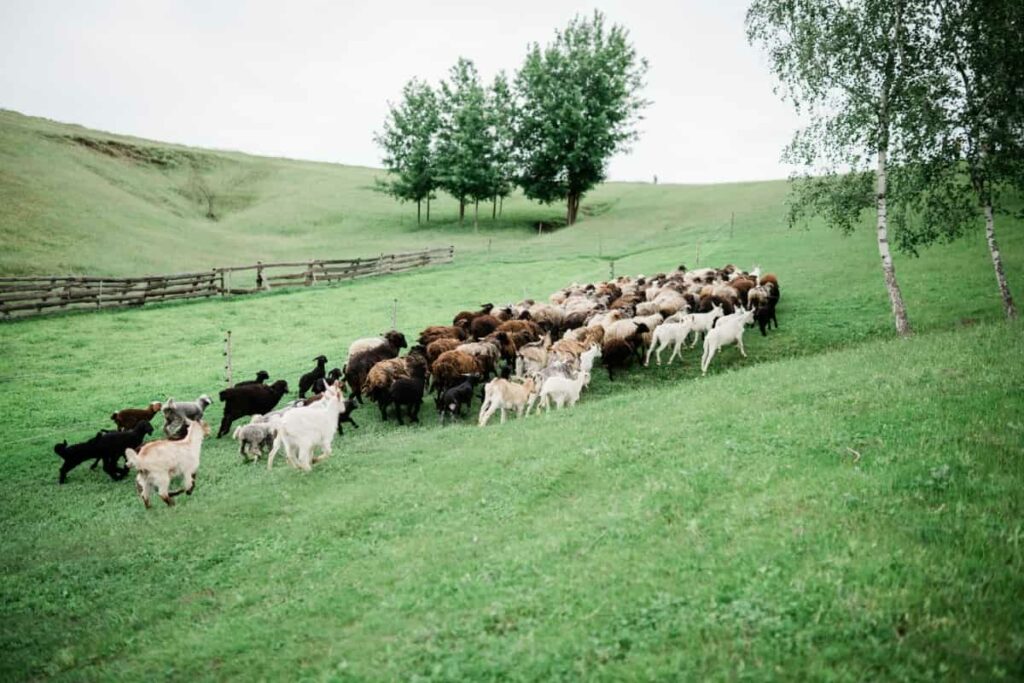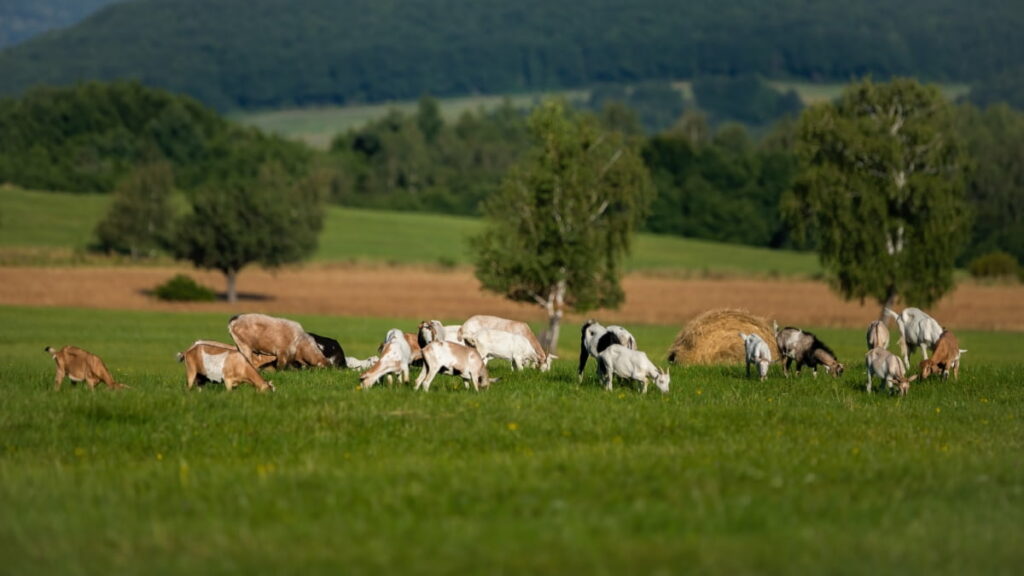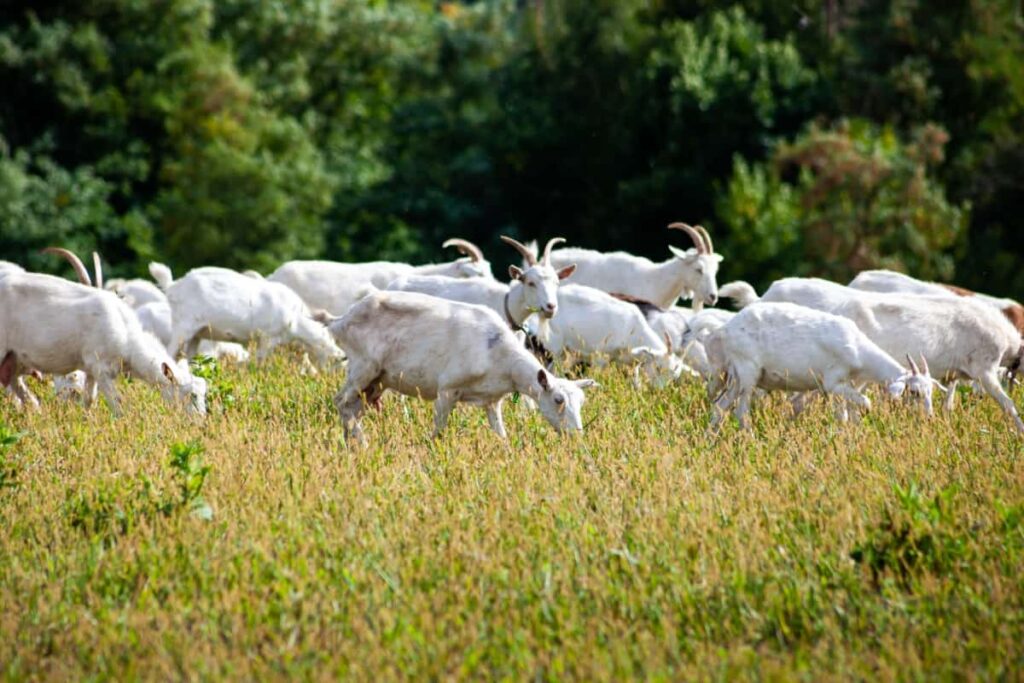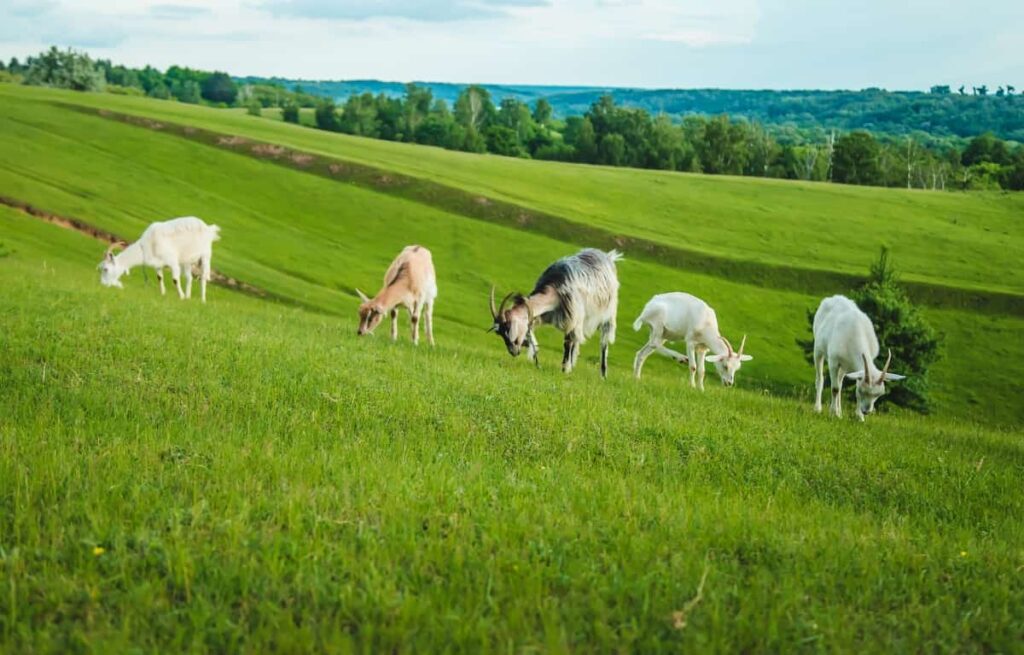Using goats as natural lawnmowers offers a multitude of benefits for both pastures and woodlands. Goats are incredibly efficient when it comes to clearing out unwanted vegetation. Utilizing goats for weed control is an eco-friendly alternative to chemical herbicides. Goats provide a sustainable solution by naturally recycling plant matter through digestion and leaving behind nutrient-rich droppings that act as organic fertilizer.

Goats for Weed Control
Benefits of Using Goats for Weed Control
The main advantage is that goats are natural weed eaters. They have a diverse palate and will happily munch on a wide range of weeds, including those pesky invasive species that can take over your land. In addition to being environmentally friendly, using goats for weed control is also cost-effective. Furthermore, goat grazing promotes biodiversity by creating space for native plants to thrive. Utilizing goats provides an opportunity for sustainable land management practices.
Selecting the Right Goat Breeds for Weed Control
Boer goat – Originating from South Africa, these goats are excellent grazers and can quickly devour weeds without damaging desired plant species. Another suitable choice is the Alpine goat, recognized for its hardiness and adaptability to various climates.
Nigerian Dwarf goats – Despite their diminutive size, they possess an impressive ability to clear out underbrush effectively. For those with larger properties or dense vegetation, the Kiko goat might be your best bet due to its robust nature and browsing capabilities.
Spanish goat – It is another fantastic choice known for its adaptability and tenacity in controlling weeds. These goats have been used historically in land restoration projects due to their ability to browse invasive plants effectively.
Alpine goats – These hardy animals are highly adaptable and possess excellent grazing skills that make them valuable assets in managing unwanted vegetation.
Preparing Pastures and Woodlands for Goat Grazing
Before introducing goats to your land, it’s important to assess and prepare the area to ensure optimal grazing conditions. Make sure you have secure fencing in place. Goats are notorious escape artists, so a sturdy fence is essential to keep them contained and prevent them from wandering into neighboring properties. Next, evaluate the vegetation in your pasture or woodland.
In case you missed it: Goat Farming Business 101: Exploring Basics of Goat Farm Business

Remove toxic plants that may pose a danger to the goats. Also, clear out any debris or obstacles that could potentially harm or hinder their movement. To maximize weed control efforts with goats, it’s beneficial to divide larger pastures into smaller sections using temporary fencing. This allows for rotational grazing, which prevents overgrazing in specific areas while giving plants time to recover and regrow. Monitor your pasture regularly during goat grazing periods.
Managing Grazing Patterns for Effective Weed Control
It’s important to divide your pasture or woodland into smaller sections. This allows you to rotate the goats between different areas, ensuring that they have a consistent supply of fresh vegetation while also preventing overgrazing. Temporary fencing or electric netting is recommended to create these separate grazing zones.
Next, consider the timing of goat grazing. Goats are known for their preference for browsing rather than grazing on grasses and clovers. Therefore, it’s beneficial to introduce them when weed species are at their most vulnerable stages of growth – typically during early spring or late fall. Supplementing goat diets with minerals and nutrients can enhance their overall health and performance while aiding in weed control efforts.
Understanding the Role of Goats in Controlling Specific Weeds
Goats are valuable allies when it comes to weed control. These nimble grazers have a unique ability to target and devour specific types of invasive plants, making them an efficient and eco-friendly solution for managing unwanted vegetation. Some breeds excel at controlling certain types of weeds, while others may be more versatile in their diet choices.
Proper preparation is essential to maximize the effectiveness of goat grazing in controlling specific weeds. Clearing any toxic plants from pastures or woodlands beforehand ensures that goats won’t accidentally consume harmful substances during their munching sessions. When implementing goat grazing as a weed management strategy, it’s crucial to manage their grazing patterns strategically.
Rotational Grazing Strategies for Maximum Weed Control
Rotational grazing is a highly effective strategy for maximizing weed control in pastures and woodlands. By dividing the grazing area into smaller sections or paddocks, you can strategically manage the movement of goats to target specific areas with high weed populations. This method allows for more efficient utilization of available forage while minimizing overgrazing. The key to successful rotational grazing is proper planning and timing. Another important aspect of rotational grazing for maximum weed control is managing browse pressure.
Goats have a natural preference for certain plants, including many common weeds. By maintaining appropriate stocking densities and monitoring their browsing behavior, you can encourage targeted weed consumption without causing excessive damage to desirable vegetation. Keep detailed records of which areas were grazed when, as well as any observed changes in weed abundance or diversity.
Supplementing Goat Diets for Optimal Health and Performance
The main aspect of maintaining optimal health is ensuring that goats have access to fresh water at all times. Additionally, providing a mineral supplement specifically formulated for goats can help ensure they receive essential nutrients that may be lacking in their natural grazing environment.
In case you missed it: Steps to Start Goat Farming in Nagaland: Housing, Health Care, and Marketing

Another consideration when supplementing goat diets is the quality of forage available to them. In addition to addressing nutrient deficiencies, supplements can also be used strategically to enhance goat performance during periods of high demand, such as breeding or lactation. It’s crucial not to overlook the importance of regular veterinary care when managing goat diets.
Monitoring and Assessing the Success of Goat Weed Control
By closely monitoring the progress, you can make necessary adjustments to optimize results. Regular visual inspections are essential for evaluating how well goats are managing the targeted weeds. Look for signs of grazing activity, such as reduced weed height or evidence of browsing. This will give you an indication of whether goats are effectively controlling the weeds in your pastures and woodlands.
In addition to visual assessments, it’s important to keep track of changes in vegetation composition over time. Monitor plant diversity and density to determine if undesirable weeds are being suppressed while desirable grasses and plants thrive. It’s also helpful to engage with experts or experienced farmers who have utilized goats for weed control before. Seek their advice on best practices for monitoring and assessing success based on their own experiences.
Considerations and Challenges of Using Goats for Weed Control
The main consideration is the initial investment required for setting up goat grazing systems. You’ll need to invest in sturdy fencing that can contain the goats and protect them from predators. Additionally, providing adequate shelter, water sources, and supplemental feed may be necessary depending on the size of your pasture or woodland. Another challenge is selecting the right goat breeds for effective weed control. Not all goats have equal browsing abilities or preferences when it comes to consuming weeds. Researching different goat breeds known for their browsing habits helps to make an informed decision.
Frequently Asked Questions (FAQ) on Goats for Weed Control
How Many Goats Do I Need for Weed Control?
The number of goats you’ll need depends on the size of your land and the severity of the weed problem. As a general rule, about six to ten goats can effectively manage one acre of land. However, it’s always best to consult with a professional goat herder or agricultural expert who can assess specific situations and recommend the appropriate goat-to-land ratio.
What Types of Weeds Can Goats Eat?
Goats are not picky eaters when it comes to weeds. They happily consume a wide range of plant species, including thistles, brambles, poison ivy, and honeysuckle. Their diverse diet helps ensure comprehensive weed control in your pastures and woodlands.
Are There Any Safety Concerns when Using Goats for Weed Control?
While generally safe animals to work with, it’s important to take precautions when utilizing goats for weed control. Make sure your fencing is secure enough to prevent escapes or interactions with other livestock or wildlife in the area. Additionally, some plants may be toxic to goats if ingested in large quantities, so familiarize yourself with potentially hazardous flora before introducing them into their browsing areas.
In case you missed it: Government Subsidy for Goat Farming in Haryana: Eligibility, Documents, and Application Process

Conclusion
Goats have been used for centuries as efficient grazers, but their abilities go beyond simply providing milk and meat. They are natural browsers with an incredible appetite for various types of vegetation, including weeds. Utilizing goats for weed control is a practice that has gained popularity in recent years, and for good reason. These animals offer a natural and sustainable solution to the problem of invasive weeds.
- Types of Grass Growing for Goat Farm
- How to Train Goats for Milking: A Beginners Guide
- Goat Milking Practices and Equipment: A Beginner’s Guide
- Goat Farming for Fiber: Producing Mohair and Cashmere
- Maximizing Goat Milk Production: Tips for Dairy Goat Farmers
- Goat Farming as a Family Business: Strategies for Success
- Profitable Kenya Goat Breeds for Commercial Dairy and Meat Business
- Unlock the Secrets of Oberhasli Goat: Discover Raising and Management Practices
- Ultimate Guide to Myotonic Goats: Explore Profile to Raising